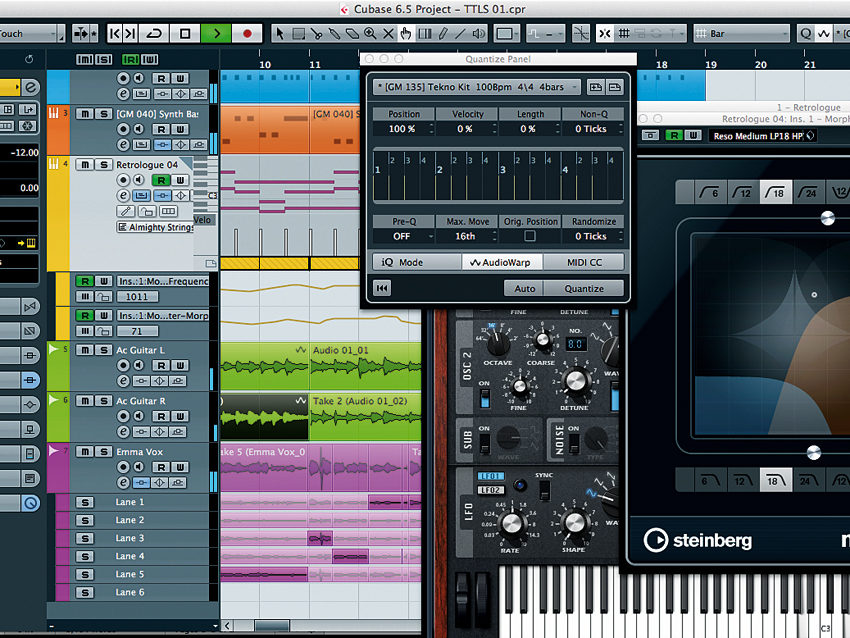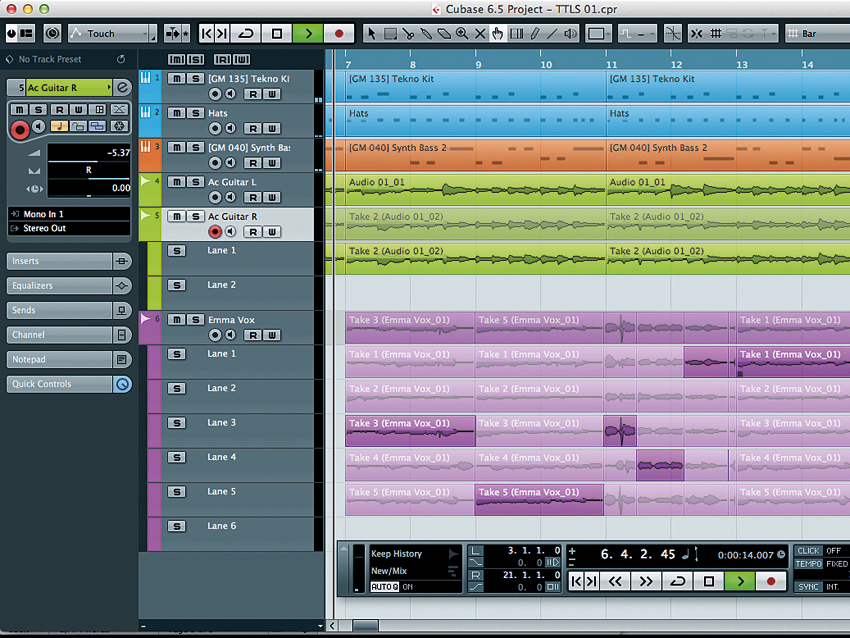MusicRadar Verdict
Cubase is as terrific as ever, and with its new features and two very cool synths, we reckon 6.5 justifies the upgrade fee.
Pros
- +
Two great new synths; enhanced comping and audio warping; 64-bit ReWire; SoundCloud integration; FLAC file support saves drive space.
Cons
- -
Still no proper sampler; can't undo mixer actions.
MusicRadar's got your back

Steinberg Cubase 6.5

Steinberg Cubase 6.5

Steinberg Cubase 6.5
Cubase started life in 1989 on the legendary Atari 1040ST, and since then it has evolved into a true one-box solution for audio and MIDI recording, sequencing, editing, mixing and mastering.
Currently available in two flavours, the full version and the cheaper Cubase Artist (Cubase Elements remains at v6), its instruments, effects and audio/MIDI-wrangling tools make it a production powerhouse.
"With the new Comp tool, you can select and slice portions of a take in one move by clicking and dragging around the areas you want to keep."
Little more than a year since Cubase 6 hit the shelves, Steinberg's release of a paid-for point release has raised a few eyebrows, because users had become accustomed to free point updates for Cubase. So what is it about Cubase 6.5 that makes it worth a further £43?
Synths you ask
To start with, the VST instrument department has been bolstered by the addition of two new synthesisers: Retrologue, a powerful, dual-oscillator virtual analogue growler; and Padshop, an intriguing granular synth. Given Cubase's relative paucity of high-quality bundled instruments (beyond the barely-editable HALion Sonic SE), these are welcome additions.
Retrologue's front panel is plastered with enough knobs to keep even the most serious synthesist busy, while retaining a familiar layout that's easy to get to grips with. The modulation matrix is comprehensive and easy to navigate. We have to say that the sound is a very pleasant surprise - it's top notch and easily on a par with respected synth plug-ins such as LennarDigital's Sylenth1 or Arturia's range of virtual analogues.
Padshop, meanwhile, is capable of some impressively eerie and quite disturbing sonic gymnastics. This is thanks to its dual-layer blending capability, granular synthesis engine and well-stocked armoury of filters, modulation and delay effects. We'd like to see the ability to import your own waveforms, but as it stands, it's still a powerful instrument.
Want all the hottest music and gear news, reviews, deals, features and more, direct to your inbox? Sign up here.
Cubase's lineup of included instruments is looking much stronger, then, although Cubase veterans may have preferred the addition of a nicely integrated workhorse sampler (barely any third-party samplers work properly with Cubase's drag-and-drop system).
Onto the effects, then. Lifted from HALion 4, MorphFilter comprises a pair of linked filters - one high-pass and one low-pass - each with a slider controlling cutoff frequency, while a third slider controls resonance.
A dot in the centre of the display can be dragged around to crossfade between the two filters, each of which can be set to 6, 12, 18 or 24dB/octave high/low-pass modes, or 12 or 24dB/octave band-pass/reject modes. MorphFilter sounds excellent, and being fully automatable, it could swiftly become the Cubase user's weapon of choice for creative filter sweeps.
The second new effect is DJ-EQ, a simple 3-band semi-parametric EQ with bands fixed at 100Hz, 1500Hz and 10kHz. Although the amount of boost is limited to 6dB, each frequency band can be cut by a whopping 32dB.
These cuts can be applied instantly by clicking the button beneath the desired frequency, somewhat like the bass, mid and treble killswitches found on DJ mixers. Like MorphFilter, the control nodes in DJ-EQ's graphic display can be automated to produce more gradual, evolving effects.
Guitarists should take note that the VST Amp Rack amp sim plug-in has new Limiter and Maximizer stompboxes as well as a collection of more than 50 new 'signature' presets.
Also new in 6.5 (and the free v6.0.6 maintenance update for those who choose to stay at v6) is 64-bit ReWire support. Thishas been on the wish lists of those looking to use 64-bit Cubase as a ReWire host for ReWire-compatible applications - like Ableton Live and Propellerhead Reason - for a while now.
Tooled up
Cubase 6 added a new take-comping system that divided opinion amongst long-term users, but v6.5's added comping functions hark back to v5's methods, so you essentially get the best of both worlds.
With the new Comp tool, you can select and slice portions of a take in one move by clicking and dragging around the areas you want to keep. Modifier keys enable you to create overlaps, slide content left or right within a comp region and resize individual parts within each lane.
Once you've defined your section boundaries, simply click the regions with the Comp tool to include them in your comp. The new Clean Up Lanes command keeps things tidy by splitting overlapping events onto their own lanes.
You can convert lanes into new tracks with the Create Tracks from Lanes command. You could create a stereo pair of tracks from two cycle-recorded guitar takes, for example.
AudioWarp - Steinberg's equivalent to Logic's Flex Time and Pro Tools' Elastic Audio - is now accessible via Cubase's Quantize panel, and there's also a new AudioWarp toolbar button, with which you can enable or disable the feature. It's great to see Steinberg's powerful audio features being liberated from the (sometimes clunky) sample editor window.
Taking the FLAC
Rounding off the new features is support for theFLAC lossless compression format as an in-project file type (meaning that audio recordings are around 60% smaller than uncompressed counterparts). Meanwhile the adoption of what Steinberg calls the 'Intercommunication 2.0 protocol' enables the exporting of project bounces directly to SoundCloud from within Cubase itself (which seems to be an increasingly popular feature for DAWs, though we can't realistically see ourselves using it much, if at all).
Interface-wise, it's basically the same as Cubase 6, which we're not complaining about. One thing we will grumble about, though, is the continued lack of undo facilities for the mixer, which is a real source of frustration at times.
The bottom line
So how's it all stack up? Existing Cubase users may well already own high-quality synths and effects, so the lure of v6.5's new ones may be diminished. However, they shouldn't be written off as simple freebies - the synths in particular are really excellent in their own right, and they come with over 700 presets between them, which ain't too shabby. They're certainly worth the upgrade fee.
Bear in mind also that, being VST3.5-compatible, they can take full advantage of the powerful Note Expression features of Cubase, which allow per-note modulations (eg, of pitchbend, filter cutoff, etc). However, it's those looking for a new DAW - especially first-timers - for whom the new features of Cubase 6.5 may hold the broadest appeal.
Computer Music magazine is the world’s best selling publication dedicated solely to making great music with your Mac or PC computer. Each issue it brings its lucky readers the best in cutting-edge tutorials, need-to-know, expert software reviews and even all the tools you actually need to make great music today, courtesy of our legendary CM Plugin Suite.
